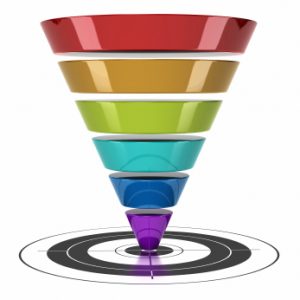Business Funnels–Marketing and Sales–What’s the Difference?
Marketing Funnel
 A system that assists in tracking the steps potential clients move through to before ultimately making a decision on the purchase of goods, or use of services. Marketing funnels let you see at each step what you need to do to influence potential clients toward the end goal, turning them into actual clients.
A system that assists in tracking the steps potential clients move through to before ultimately making a decision on the purchase of goods, or use of services. Marketing funnels let you see at each step what you need to do to influence potential clients toward the end goal, turning them into actual clients.
Sales Funnel
Refers to the buying process that businesses direct a client through when purchasing products or obtaining services. Like a Marketing funnel, it is divided into several steps. These steps will differ according to your particular sales model.
Or to put it more simply, marketing funnel is about capturing a lead and taking people to the point of a sale where a sales funnel captures and then leads people through the sales process via a series of pitches, etc.
In businesses where the marketing and sales departments/people are separate roles from one another, the two different concepts are implemented separately with Marketing Funnels working to create interest at the top and acquire clients at the bottom, these acquisitions becoming the top of the Sales Funnel.

In smaller businesses, this distinction may become a little muddled as employees may need to wear multiple hats, but for the sake of this article, we’ll go with the simplest viewpoint.
Your marketing is responsible for compelling an individual to become a potential client by creating awareness. It will typically focus on a broad area through a variety of methods, with the idea of attracting as much interest as possible. These days this of commonly done via social media, paid advertising, blog posts, and PR. Thanks to the internet, the possibilities are almost endless when looking for a target audience.
This initial scouting is the TOP of the marketing funnel. The goal of these endeavors is to provide enough information to interest the general masses in taking action and becoming potential clients.
The final goal is to end up getting the potential client to provide contact information and hopefully specific product interest. This can be accomplished in a number of ways including a free eBook download, providing a contact form with the promise of more info, calling a toll-free number, or any other process you can collect their details. This result makes up the BOTTOM of the marketing funnel.
By acquiring this info from a potential client, you will then be able to move them into the procedures outlined on the sales side and bring them to the TOP of the Sales Funnel.
Different businesses will show a variety of ways that this transition from Marketing to Sales may happen, but the overall desired result will be the same, gaining a loyal and long term client that will refer others to a business’s products and services.
So essentially, sales have the power to change condition through the skills of the sales team. A sales funnel dictates the actual steps used to lead your customer towards the final goal, the actual purchase or use of services that you are offering.
Marketing, however, generally does not possess this same power. It needs to work with conditions as they come. The use of a marketing funnel is to create some anticipation about what is being offered or sold.
Both Marketing Funnels and Sales Funnels can become very complex systems with numerous sub-steps within each primary step, depending on who your client is compared to what you are offering.
Monitoring the social media marketing landscape is vital to your success. If you’d like to have access
to even more powerful marketing tips, as well as a way to generate conversion-ready Internet marketing prospects each month, check out my done-for-you-system.
Sam is the founder of 3DLifeStyleee Academy. After working as a Software Engineer for over 18 years for some of the biggest Fortune 500 companies like Cisco Systems, Hewlett Packard, Symantec, Apple, Expedia, etc., he realized that his dreams were too big to be fulfilled working for someone else. So he ventured out as an Entrepreneur in his quest to design a lifestyle that he always desired for him and his family.
Prior to 3DLifeStyleee Academy, he also built and successfully launched two of his own software products.







